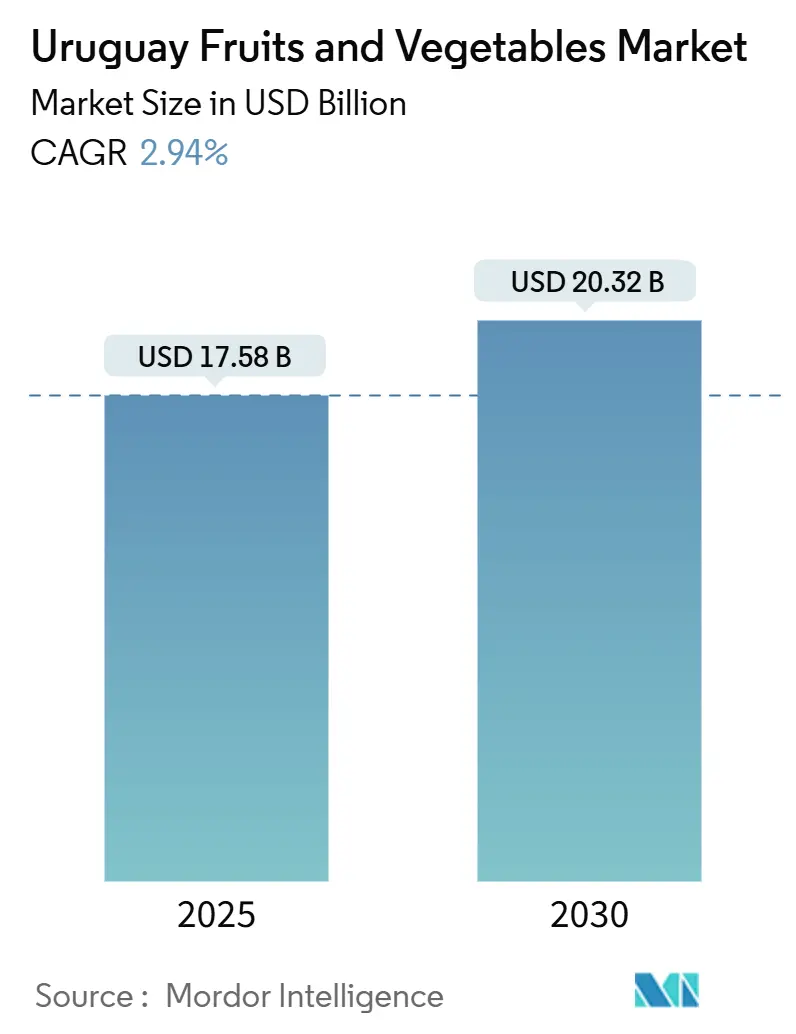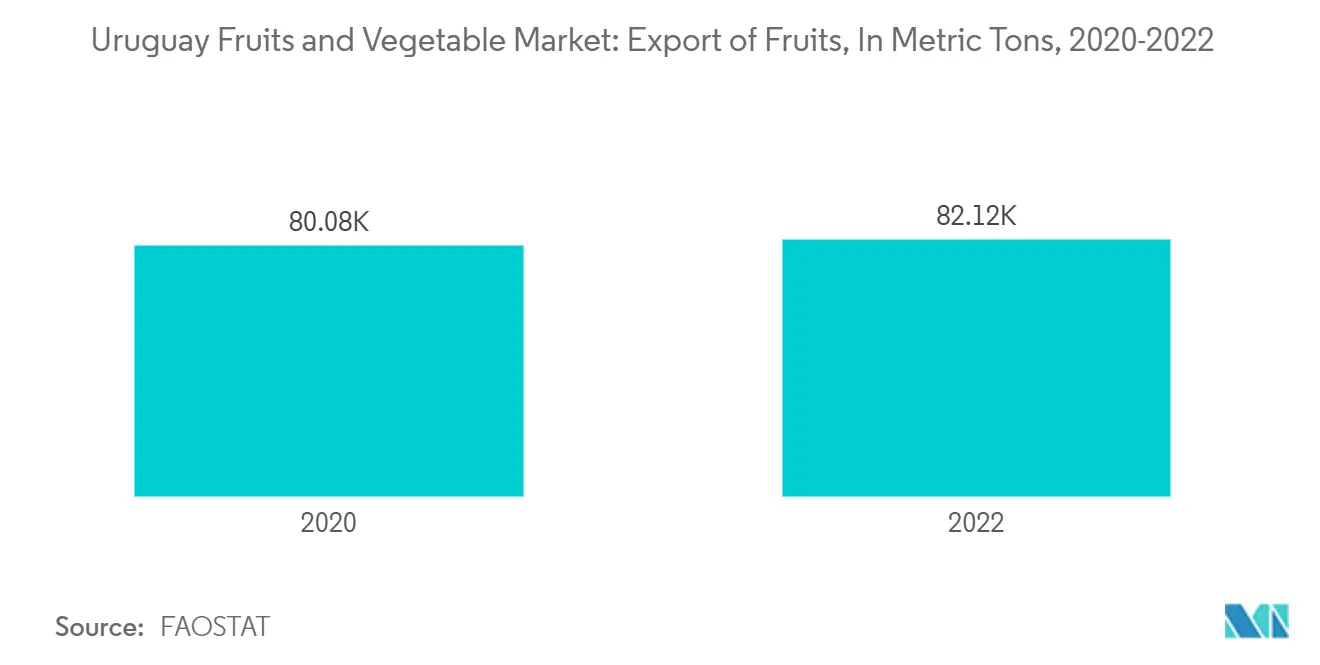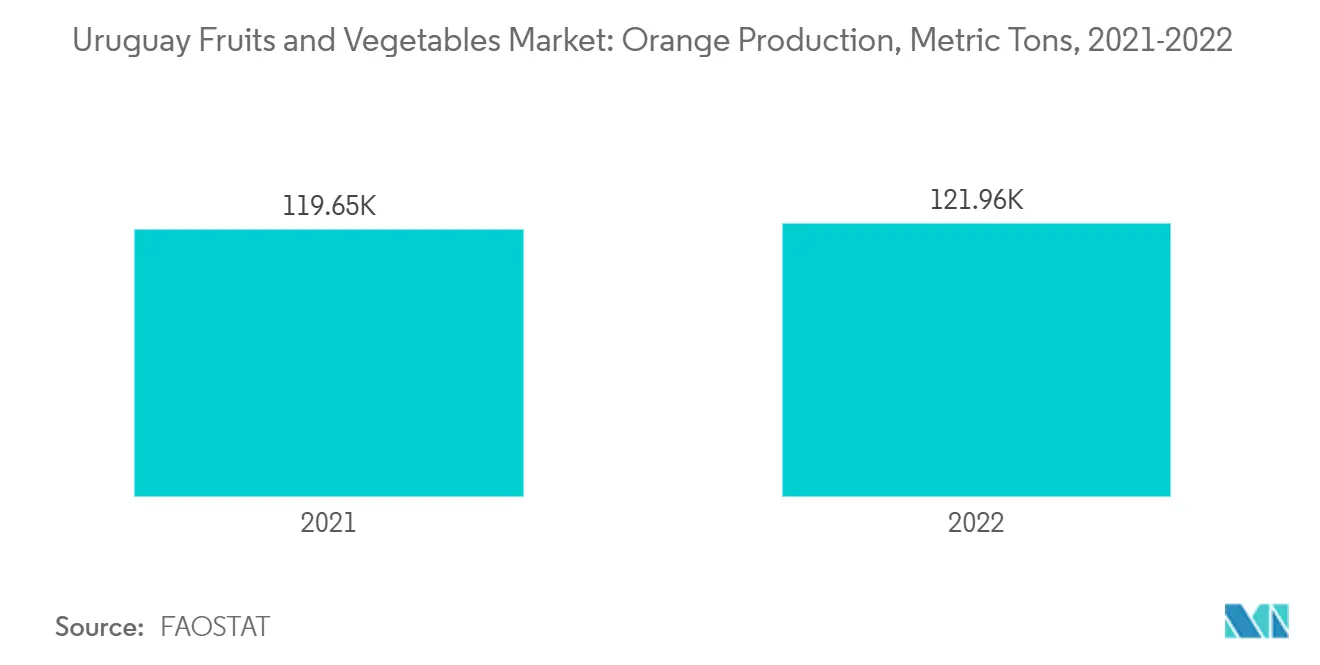
Uruguay Fruits And Vegetables Market Analysis by Mordor Intelligence
The Uruguay Fruits And Vegetables Market size is estimated at USD 17.58 billion in 2025, and is expected to reach USD 20.32 billion by 2030, at a CAGR of 2.94% during the forecast period (2025-2030).
Uruguay's fruit and vegetable market is a cornerstone of the nation's agricultural sector and local economy. While livestock and beef production dominate, the agriculture sector, encompassing fruits and vegetables, plays a pivotal role in bolstering domestic consumption and generating export revenues. Uruguay’s temperate climate is well-suited for a variety of fruits and vegetables. The country's rich soil and optimal growing conditions support the cultivation of crops ranging from citrus fruits and apples to vegetables like lettuce and tomatoes.
Uruguay's agricultural landscape boasts a variety of fruits, including citrus (oranges, lemons, mandarins), apples, pears, grapes, and even tropical delights like kiwis. The nation also cultivates avocados, strawberries, and an assortment of berries. For instance, according to FAOSTAT, orange production in Uruguay was 119,646 metric tons in 2021, which increased by 121,961.79 metric tons in 2022. Key vegetable crops span lettuce, carrots, potatoes, onions, tomatoes, and pumpkins, all of which play a vital role in the domestic food supply and local markets.
Fruits and vegetables hold a prominent place in the Uruguayan diet, with many traditional dishes spotlighting fresh produce and a strong preference for local items. The distribution network is robust, encompassing wholesalers, supermarkets, local markets (ferias), and neighborhood grocery stores. Urban centers, particularly Montevideo, exhibit heightened demand for fresh produce, with farmers’ markets being instrumental in meeting this urban appetite.
Uruguay actively exports a diverse range of fruits and vegetables to both regional and global markets. Among these, citrus fruits, especially oranges and lemons, stand out, with substantial exports directed toward Europe and the United States. Other notable exports include apples, pears, and grapes, primarily sent to South American neighbors, Europe, and the US. For instance, according to g to ITC Trade Map, orange export from Uruguay was USD 12,741 thousand in 2021, which increased by USD 18,352 thousand in 2022.
Uruguay Fruits And Vegetables Market Trends and Insights
Growing Export Potential
Uruguay's fruit and vegetable market thrives on its burgeoning export potential. By forging strategic agreements with global players like the European Union and the United States, Uruguay has carved a niche in international trade. These pacts not only slash tariffs but also simplify regulatory hurdles, enhancing the appeal of Uruguayan produce on the global stage. Upholding stringent international quality and food safety standards, Uruguay has cemented its status as a trusted fresh produce supplier. Its dedication to certifications and global regulations further elevates its products in discerning markets.
From citrus fruits like oranges, lemons, and mandarins to apples, pears, and grapes, Uruguay boasts a rich tapestry of fruits and vegetables. With offerings that include lettuce, carrots, and onions, the nation's diverse produce portfolio ensures a broad market reach, mitigating over-reliance on any single export. For instance, according to FAOSTAT, fruit export from Uruguay was 80,079.11 metric tons in 2020, which increased by 82,115.19 metric tons in 2022. Furthermore, advancements in cold storage and transportation have significantly extended the shelf life and quality of Uruguayan produce, making long-distance exports feasible. Such enhancements are pivotal for shipping perishables to distant markets in Europe, North America, and Asia.
As global awareness of health and wellness intensifies, so does the demand for fresh, natural foods. Consumers worldwide are on the lookout for nutritious, pesticide-free fruits and vegetables. With its emphasis on quality control and sustainable farming, Uruguay is poised to satisfy this growing appetite.

Fruits Dominate the Market
Uruguay's Ministry of Livestock, Agriculture, and Fisheries reports that fruits dominate the nation's agricultural production value. Agriculture, which makes up about 12 percent of Uruguay’s GDP (though roughly 70 percent of exports are agriculture-based), plays a leading role in Uruguay’s economy. Agricultural exports, vital for meeting the population's basic food needs, constitute a hefty 71% of the country's total goods exports, leading to a notable export surplus. Among fruits, citrus varieties—like oranges, mandarins, and grapefruits—lead the pack, trailed by grapes, apples, and blueberries. Key citrus-producing regions in Uruguay include Salto, Paysandu, and Florida. As the area under horticultural cultivation expands, so does the export value, signaling a rising domestic demand for fruits. For instance, orange production in Uruguay was 119,646 metric tons in 2021, which increased by 121,961.79 metric tons in 2022.
Uruguay's temperate climate and fertile soil provide an ideal backdrop for diverse fruit cultivation. This natural edge ensures not only consistent yields but also fruits of a quality that meets global standards. The country's climate accommodates a spectrum of fruits: from citrus (oranges, lemons, mandarins) and temperate varieties like apples and pears, to grapes and even tropical delights like kiwis and avocados. This diverse production empowers Uruguay to tap into various international markets and adapt to seasonal demands.
Modern farming techniques—ranging from precision agriculture and drip irrigation to the use of premium seeds—have revolutionized fruit production in Uruguay. These innovations not only enhance yield and fruit quality but also optimize water usage and minimize waste. Furthermore, heightened investments in agricultural tech, especially in automated planting and harvesting equipment, have amplified production efficiency while curtailing labor costs.

Recent Industry Developments
- January 2023: After 30 years of research and development, Uruguay’s Citrus Breeding Program has launched six new citrus varieties. The innovation was a joint effort led by the National Institute of Agricultural Research (INIA) and the University of the Republic of Uruguay, through the Citrus Consortium of Uruguay.
- June 2022: Uruguay's blueberry industry received new market access to Israel. It provides a good opportunity for Uruguay to serve its new varieties of superior quality and long-shelf life blueberries in Israel.
Uruguay Fruits And Vegetables Market Report Scope
Fruits and vegetables are important supplements to the human diet as they provide the essential nutrients required for maintaining health. Uruguay produces several horticultural crops, including bananas, onions, pineapples, and tomatoes. The Uruguay fruits and vegetables market is segmented by crop type into fruits and vegetables. The Uruguay Fruits and Vegetables Market includes Production Analysis (Volume), Consumption Analysis (Value and Volume), Export Analysis (Value and Volume), Import Analysis (Value and Volume), and Price Trend Analysis. The market sizing has been done in Value (USD) and Volume (Metric Tons) for all the abovementioned segments.
Key Questions Answered in the Report
How big is the Uruguay Fruits And Vegetables Market?
The Uruguay Fruits And Vegetables Market size is expected to reach USD 17.58 billion in 2025 and grow at a CAGR of 2.94% to reach USD 20.32 billion by 2030.
What is the current Uruguay Fruits And Vegetables Market size?
In 2025, the Uruguay Fruits And Vegetables Market size is expected to reach USD 17.58 billion.
What years does this Uruguay Fruits And Vegetables Market cover, and what was the market size in 2024?
In 2024, the Uruguay Fruits And Vegetables Market size was estimated at USD 17.06 billion. The report covers the Uruguay Fruits And Vegetables Market historical market size for years: 2019, 2020, 2021, 2022, 2023 and 2024. The report also forecasts the Uruguay Fruits And Vegetables Market size for years: 2025, 2026, 2027, 2028, 2029 and 2030.
Page last updated on:
Uruguay Fruits And Vegetables Market Report
Statistics for the 2025 Uruguay Fruits And Vegetables market share, size and revenue growth rate, created by Mordor Intelligence™ Industry Reports. Uruguay Fruits And Vegetables analysis includes a market forecast outlook for 2025 to 2030 and historical overview. Get a sample of this industry analysis as a free report PDF download.

